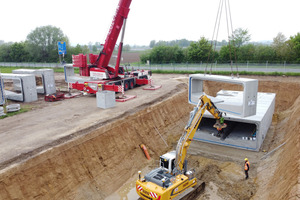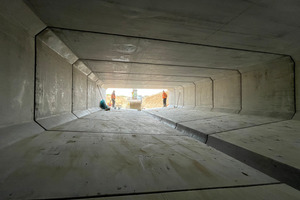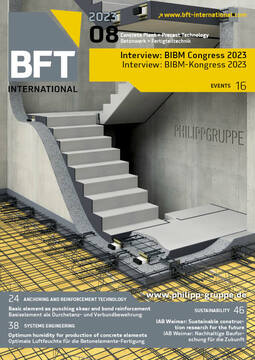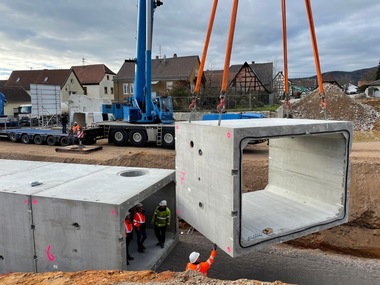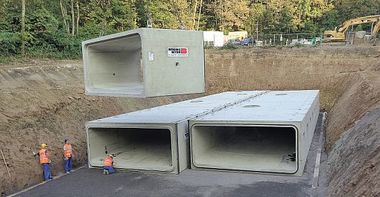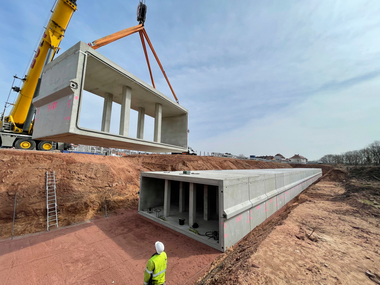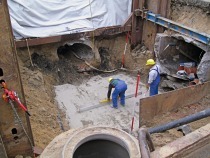Storage sewer for industrial estate and research airport
The Aachen-Merzbrück Business Airport (VLP), with around 42,000 annual aircraft movements, is a key airport in North Rhine-Westphalia, Germany. Expanding the airport to become a research facility is intended to strengthen the Aachen area as a research center, secure business flights, reduce aircraft noise and make air traffic safer. As part of this project, the old runway/landing strip was stripped and replaced by a tilted runway, 1,160 m long, plus taxiways.
VLG is of special significance for research and science, since the two chairs for aeronautics and astronautics of RWTH Aachen University research and teach there. A large-dimensioned storage sewer in the development area is among the systems that ensure orderly rainwater management and that pass on accumulated precipitation at reduced flow rates. For this structure, the planners decided on a construction with rectangular frame profiles of reinforced concrete.
Open rainwater settlement basin of reinforced concrete
The engineering company IQ Ingenieurgesellschaft Quadriga mbH from Würselen in Germany, charged with planning this system, explained how drainage of precipitation at the site is controlled: “The accruing precipitation is initially collected in a rainwater sewer. Pre-treatment of the rainwater prior to infiltration takes place in an open rainwater settlement basin which, as flow-through basin, is operated without continuous water backup. The rainwater settlement basin, constructed as an open rectangular basin in reinforced-concrete, is filled via a DN 1200 rainwater collector. The retention volume of the rainwater settlement basin up to the height of the spillway is approx. 71 m³. The basin floor was executed with a gradient of 2 % toward the drainage channel to enable the settled pollutants to flow to the discharge valve during drainage.
The floor of the basin consists of a trenching structure of washed gravel, a geotextile and sand-gravel layer as well as a 30-cm activated layer of soil. Because the separation wall between the two channel profiles has a height of 80 cm, the infiltration basin is divided into two sections, which can be flooded separately. The drainage openings of the overflow basin can be closed with a removable dam beam,” explains the planner at IQ Ingenieurgesellschaft Quadriga mbH.
26 reinforced-concrete frame profiles with dry weather channel
The largest underground structure, however, is a combined-sewage storage unit consisting of 26 reinforced-concrete steel profiles with dry weather channel and two face plates – manufactured by Betonwerk Kleihues of Emsbüren in Germany. Martin Gustowski continues: “The individual building components measure 7.7 x 1.92 x 3.4 m, resulting in a total storage volume of approx. 700 m³. A throttle structure consisting of four rectangular profiles is located behind the storage sewer. Access openings are provided in the feed and discharge channels, as well as in the middle of the storage sewer,” explains the planner at IQ Ingenieurgesellschaft Quadriga mbH.
Betonsteinwerk Kleihues delivers elements weighing 50 tons
The elements of which the storage sewer is composed consist of frame profiles weighing just short of 50 tons, manufactured by a contact process in the plant Betonsteinwerk Kleihues, in Emsbüren, Germany. They were erected by Willy Dohmen GmbH & Co. KG from Übach-Palenberg, Germany. Site Manager Torsten Engelen describes the erection process: “The advantage of this construction method is that the precast elements are manufactured in the plant subject to continuous quality control,” explains Engelen.
“This is the reason why the elements, compared to in-situ construction, are of higher concrete quality. The material can be efficiently used so that the elements can be produced narrower, resulting in savings in concrete and costs and accordingly also CO2 emissions. This construction method, moreover, requires markedly fewer work steps. This simplifies the entire construction project and, accordingly, reduces possible error sources as well. Erection took place in only five days and therefore required noticeably less time than an in-situ construction,” according to Engelen.
CONTACT
Kleihues Betonbauteile
GmbH & Co. KG
Siemensstr. 21
48488 Emsbüren/Germany
+49 5903 9303-0

